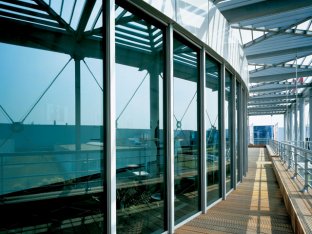
Safety glass is glass with additional safety features that make it less likely to break, or less likely to pose a threat when broken. Common designs include toughened glass (also known as tempered glass), laminated glass, and wire mesh glass (also known as wired glass)
Laminated glass holds together when shattered because, in the event of breaking, it is held in place by an interlayer, typically of polyvinyl butyral (PVB), between its two or more layers of glass. The interlayer keeps the layers of glass bonded even when broken, and its high strength prevents the glass from breaking up into large sharp pieces. This produces a characteristic "spider web" cracking pattern when the impact is not enough to completely pierce the glass.
Laminated glass is normally used when there is a possibility of human impact or where the glass could fall if shattered. Skylight glazing and automobile windshields typically use laminated glass. In geographical areas requiring hurricane-resistant construction, laminated glass is often used in exterior storefronts, curtain walls and windows. The PVB interlayer also gives the glass a much higher sound insulation rating, due to the damping effect, and also blocks 99% of incoming UV radiation.
Wire mesh glass is glass that has a thin wire, usually made of metal, running through the glass. Wired glass, as it is typically described, does not perform the function most individuals associate it with. The presence of the wire mesh appears to be a strengthening component, as it is metallic, and conjures up the idea of rebar in reinforced concrete or other such examples. Despite this belief, wired glass is actually weaker than unwired glass due to the incursions of the wire into the crystalline structure of the glass. Wired glass often also causes heightened injury in comparison to unwired glass, as the wire amplifies the irregularity of the fractures. This has led to a decline in its use institutionally, particularly in schools. Wired glass instead is utilized for its fire-resistant abilities, and is well-rated to both withstand heat and a hose stream.
This is why wired glass is exclusively used on service elevators to prevent fire ingress to the shaft and why it is also commonly found in institutional settings which are often well-protected and partitioned against fire. The wire prevents the glass from falling out of the frame even if it cracks under heat stress, but is far more heat-resistant than a laminating material. These three approaches can easily be combined, allowing for the creation of glass that is at the same time toughened, laminated, and contains a wire mesh.However, combination of a wire mesh with other techniques is unusual, as it typically betrays their individual qualities.
